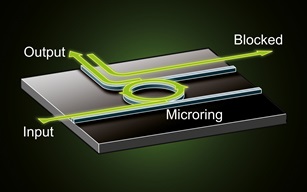15 Mar 2018
Photonics researchers at the National Physical Laboratory (NPL) have achieved the extra-ordinary by creating a diode consisting of light that can be used, for the first time, in miniaturised photonic circuits, as published in Optica.
Dr Pascal Del'Haye and his team at NPL have created an optical version of a diode that transmits light in one direction only, and can be integrated in microphotonic circuits. This small-scale integration has been a major challenge in photonics because existing optical diodes require bulky magnets.
NPL's ground-breaking work has overcome the limitation of diodes based on bulky magnets, by using light stored in tiny chip-based glass rings to form a diode.
Diodes are well known in electronic circuits. They transmit electric current in one direction but block the current in the backward direction. Diodes are essential components of nearly every electronic circuit and are used, for example, in battery chargers.
The novel technique was created by sending lots of light into a microresonator – a glass ring on a silicon chip, about the width of a human hair – and harnessing the circulating optical power to generate the diode effect.
Dr Jonathan Silver, Higher Research Scientist at NPL, explains: "To create the optical diodes we used microrings that can store extremely large amounts of light. This meant that, even though we were only sending small amounts of light into these glass rings, the circulating power was comparable to the light generated by the flood lights in a whole football stadium - but confined into a device smaller than a human hair. The light intensities enable the formation of a diode via a light-with-light interaction called the Kerr effect."
In their experiments, they have shown that the electromagnetic field of clockwise circulating light in these glass rings effectively blocks any counterclockwise circulating light.
Pascal Del'Haye, Principal Research Scientist of the project emphasises: "These diodes will, for the first time, open the door to cheap and efficient optical diodes on microphotonic chips, and will pave the way for novel types of integrated photonic circuits which could be used for optical computing.
"They could also have significant impact on future optical telecommunication systems, for more efficient use of telecom networks."
Leonardo Del Bino, Doctoral Student on the project, said: "A remarkable property of this novel diode is that the performance improves if the forward propagating light field is increased. This is very important, for example, when using the diode to protect chip-integrated laser diodes from back reflections."
Beyond the use for optical diodes, NPL's research on interaction of counterpropagating light can enable new types of optical rotation sensors and optical memories.
Read the paper published in Optica















